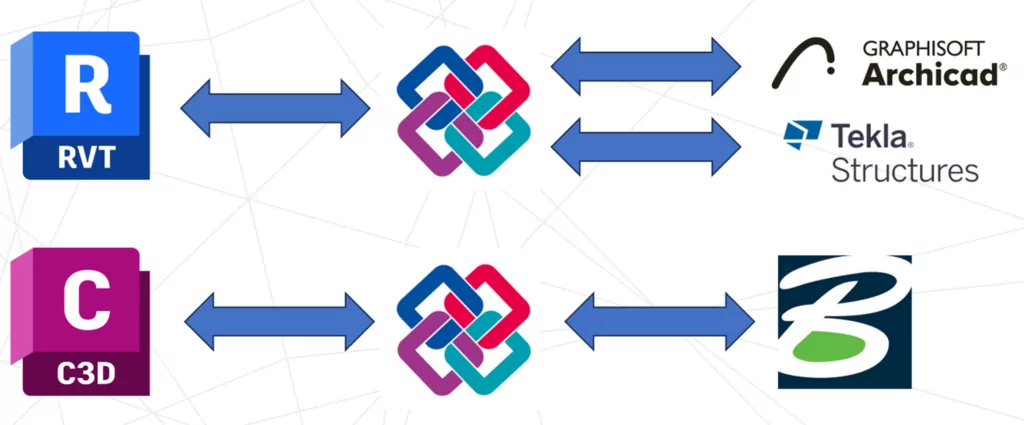IFC (Industry Foundation Classes)
GISBox is a one-stop 3D GIS data editing, conversion and publishing platform that supports editing in multiple GIS formats such as OSGB/GEOTIFF/RVT, converting to 3DTiles/Terrain and publishing.
Introduction
IFC (Industry Foundation Classes) is an open BIM (Building Information Modeling) file format widely used in the construction industry. The IFC format was developed by buildingSMART, an international building standards organization, to promote data sharing and collaboration between different software tools in the construction industry. It is an open standard for describing all relevant data and information in construction and building engineering projects, such as buildings, equipment, structures, materials, etc. This allows information in the building design, engineering and construction process to flow seamlessly between different software.

File Structure
The IFC architecture is divided into four layers:
- Domain layer: defines the information in each domain, such as boilers, fans, dampers, etc. in the HVAC field.
- Shared layer: defines the information exchanged across disciplines, such as walls, beams, columns, doors, windows, etc.
- Core layer: defines the overall framework of the information model, such as the relationship between engineering objects, the position and geometry of engineering objects, etc. This layer mainly describes the overall framework of building engineering information. It organizes the information of the resource layer with an overall framework, so that they are interconnected and connected to form a whole, truly reflecting the structure of the real world.
- Resource layer: mostly basic information definitions, such as materials, geometry, topology, etc.
Pros
- **Open standard, cross-platform compatibility: **The IFC format is an open standard that supports data exchange between a variety of building design and management software (such as Revit, ArchiCAD, AutoCAD, etc.). It solves the compatibility issues between different CAD and BIM tools, promotes cross-platform and cross-software data flow, and improves team collaboration efficiency. This openness allows participants in the construction industry to use software they are familiar with while ensuring information sharing and collaboration.
- **Full life cycle information management: **The IFC format can cover the entire life cycle of a building project, from the design stage to construction, to operation and maintenance. It can record key data such as the building’s geometric information, structure, system, and materials, which facilitates later facility management and maintenance. Through IFC files, various types of building data can be archived and managed for a long time, providing an important basis for future maintenance, renovation or transformation.
- **Promote collaboration and information sharing: **The IFC format facilitates collaboration and data sharing between different professional teams (such as architectural designers, structural engineers, mechanical and electrical engineers, etc.). Because it provides a unified data format and standard, all parties can exchange and review project data through IFC files, avoiding information barriers between different design tools. This helps improve project transparency, reduce design conflicts, and ensure the project proceeds smoothly.
Cons
- **Large file size: **Since IFC files contain a lot of design and construction information, especially for large construction projects, the file size can be very large. Processing and transferring large IFC files may take a long time and may require high computer performance. On some low-configuration devices, loading and processing these files may be very slow, affecting work efficiency.
- High complexity: Although the IFC format can provide detailed building information, it is relatively complex. The structure of IFC files is relatively complex, and for some designers or engineers, understanding and using the IFC format may require a certain learning curve, especially when the project data is very large. In addition, the learning and use costs of the IFC format are high, especially for new users.
- Differences in software support: Although IFC is an open standard, different architectural design and BIM software have different levels of support for IFC. Some software may experience data loss or incompatibility when reading, importing, and exporting IFC files. Especially when it comes to some special components, annotations, or design elements, the compatibility issues of IFC files may cause information loss or format confusion, thus affecting the accuracy and integrity of the project.
Application Scenario
IFC files are used to achieve cross-software and cross-platform data sharing and collaboration throughout the entire life cycle of the architecture, engineering and construction (AEC) industry, supporting information integration and interoperability in various stages such as design, construction, operation and maintenance.
Example
- Examples of the interoperability benefits of IFC files.

- Schematic diagram of the IFC file usage process.
